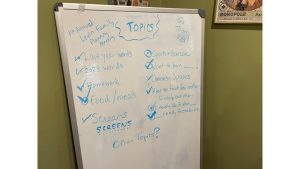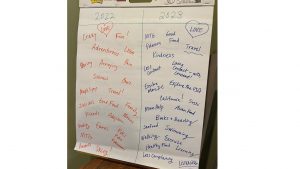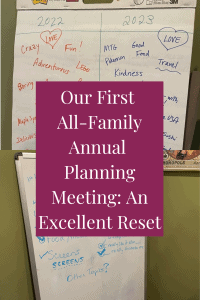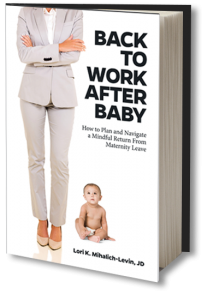 With the first annual all-family Levin planning meeting in the books, I’m writing to report on how this family activity went.
With the first annual all-family Levin planning meeting in the books, I’m writing to report on how this family activity went.
To rewind a bit, I’ve shared before that my husband and I are avid fans of the process of planning. We do a weekly planning meeting together on Saturday nights. (More on how to engage your partner in one of these types of weekly check-ins here.)
For the past 10 years, we’ve also devoted a day, typically toward the end of the year, to an annual planning exercise. We’ve found this to be a really steadying practice for us as a couple. It gives us the chance to review the prior year, look ahead to the future, and re-connect to one another.
A few weeks ago, during this year’s December planning meeting, my husband offered an excellent suggestion: that our kids were probably old enough to participate in an annual planning activity that involved them. Our boys are now 12 and almost 10. And yes indeed, they’re old enough for this. (To be honest, they probably would have been a few years ago!)
We picked a day over the holidays to sit down with them. We described what exactly an “annual planning meeting” was. And then, we unveiled the list of topics we wanted to discuss, which I had written on a white board. Pictured above.
All-Family Planning: The Topics We Covered
With a decade of our own annual planning experience under our belts, we knew what topics would likely be important for this all-family meeting. But we also knew we’d need to tweak them for the kids’ purposes. Here’s the list of topics we landed on:
- Last Year’s Words: We did a word storm, naming words that described how we each felt about 2022.
 2023 Words: We then did a word storm of words that described how we want to feel about 2023.
2023 Words: We then did a word storm of words that described how we want to feel about 2023.- Homework: We talked about how each child approaches homework and what we can do to make the after-school hours go more smoothly moving forward. One of our kids, in particular, had been struggling mightily against doing his homework. We used this time together to listen to his views and feelings on the situation, and to brainstorm – and then commit to – possible solutions to some of his angst.
- Food / Meals: We talked about breakfasts, lunches, snacks, and dinners. My husband and I also announced our new plan to have the kids cook dinner for the family once every weekend.
- Screens: Yep, this had to go on the list. We talked about screen usage for the entire family and came up with some good new guidelines. (This included making more permanent an experiment we tried over break, in which the kids were each able to earn additional screen time by reading chapter books quietly in their rooms.)
- Sports & Exercise: We talked through each child’s sport and activity preferences for the winter and spring. Also, we brainstormed and come up with some plans for staying active during these cold months.
- “I want to learn {X}!”: We each listed one thing we wanted to learn this coming year. Then we talked about specific, concrete steps we could take to make that thing happen.
- Common Spaces: A perennially important topic, we talked about how to respect the common spaces we live in. We talked about the history of traditional gender norms and also about how we can each do our own part to contribute to making our spaces clean and livable.
- How We Treat One Another & Help Each Other: This involved airing some grievances, of course. But it helped us re-establish some explicit rules around respect and kindness.
- “I really like it when {X}.”: I designed this prompt to elicit things we wanted to see more of. Each person said one thing that each other family member did that they really liked.
- “It really frustrates me when {X}.” Yes, a few more grievances here. We framed this prompt as things we can be mindful of. I also explained that we each have things that drive us batty, possibly for no good reason, and it’s just good to know what that trigger is for each family member.
We also invited the kids to bring their own topics to the conversation. Our boys reviewed the list and thought it covered everything they wanted to discuss, though, so we didn’t add anything else.
How did All-Family Planning Go?
Our kids arrived at this meeting with a spirit of true curiosity. Having never done something like this before, they didn’t really know what they were in for! I’ll be fascinated to see how they respond to the announcement of the all-family meeting next year (or the check-in this summer), after they’ve experienced it once.
We let each child take turns picking a topic, so we didn’t necessarily go in the order listed above. We also discovered that this list was way too much content to address at once. They kids’ attention (quite understandably) flagged after about an hour. So we broke the meeting up into two parts and finished it on another day.
One discussion that surprised me was that the “you, kids, will be cooking dinner once a week” announcement was met with a surprising amount of glee. (I’m chalking it up to the many, many Master Chef Junior episodes we watched during the pandemic!) They immediately ran to the shelf with our cookbooks and started looking through them…and it was hard to get them back on track for the rest of the meeting. A good problem to have, for sure. And their first meal under the new plan was a truly delicious chicken and waffles with a side of roasted Brussel sprouts.
We’re now a few weeks out from this all-family meeting adventure, and the report is definitely positive. My one son’s homework struggles are not completely gone, but they have been *greatly* reduced. He seems to understand that he’s been heard and that he helped contribute to a solution. The boys still bicker (they are, after all, still siblings). But they also have talked and laughed more, too. After one son aired his frustrations about how much the other son sang, the frustrated son has started singing himself. Go figure.
The meeting is also serving as an anchor. I took good notes with a sharpie and magic marker on some huge paper while we were talking, so we can literally point back to the agreements we came up with.
And most of all, I’m proud that we, as parents, were able to model for our kids how to look back, look ahead, and open up constructive dialog. What I hope they take away from this all-family planning exercise, ultimately, is that talking about things in a productive and open way – rather than ignoring them – is always the healthier approach.
Onward to the rest of 2023!
Want more practical tips on working parenthood? Check out my book, Back to Work After Baby: How to Plan and Navigate a Mindful Return from Maternity Leave




Love how you extended this practice to your children!
Thank you so much, Sara! It was so helpful, and I look forward to doing it again!
This is fantastic, Lori! Our family definitely needs a planning session like this. Thank you.
Thank you, Bhavna! Do let me know how it goes if you try it out!